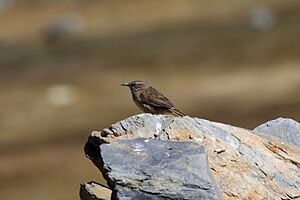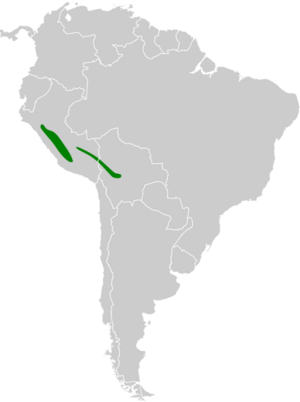Streak-throated canastero facts for kids
Quick facts for kids Streak-throated canastero |
|
|---|---|
 |
|
| Conservation status | |
| Scientific classification | |
| Genus: |
Asthenes
|
| Species: |
humilis
|
| Subspecies | |
|
See text |
|
 |
|
The streak-throated canastero (scientific name: Asthenes humilis) is a type of bird. It belongs to the ovenbird family, which is known for building unique nests. You can find this bird in the countries of Bolivia and Peru.
Contents
About Its Name and Types
The streak-throated canastero has three slightly different types, called subspecies. These are A. h. humilis, A. h. cajamarcae, and A. h. robusta. Scientists named these different types after they were first discovered. For example, A. h. humilis was named by a scientist named Jean Cabanis in 1873.
What Does It Look Like?
The streak-throated canastero is about 15 to 16 centimeters (6 inches) long. It weighs around 23 to 24 grams (less than an ounce). Both male and female birds look the same.
Feathers and Colors
This bird has a dull, light-colored stripe above its eye. Its face is streaked with dark brown and grayish-buff colors. The top of its head is dark brown with faint streaks. Its back, rump, and tail feathers are dull dark brown. The streaks on its back get longer towards its rump.
Its wings are mostly dark brownish. Some feathers have a reddish-brown color. The tail is dark brown with light, yellowish-brown edges on the outer feathers.
Underparts and Beak
The chin of the streak-throated canastero is orange-red. Its throat and chest are pale brown. The belly is even lighter brown. Its sides and under-tail feathers are a warmer brownish-buff. The throat has thin, dark streaks that fade on the upper chest.
Its eyes are brown. The upper part of its beak is black to dark horn-colored. The lower part is blackish to gray with a black tip. Its legs and feet are grayish-olive to brownish-gray.
Young Birds
Young streak-throated canasteros have less orange on their throats. Their throat streaks are also not as clear. They might have some reddish-brown color on their tails.
Differences in Subspecies
The A. h. cajamarcae subspecies has grayer upper parts than the main type. Its streaks are clearer. Its underparts are paler and less buffy. The A. h. robusta subspecies has a darker back with less clear streaks.
Where Does It Live?
The streak-throated canastero lives in the Andes mountains of Peru and Bolivia. It is found in different areas that are not connected.
Specific Locations
The A. h. cajamarcae subspecies lives in Peru's Department of Cajamarca. The main subspecies, A. h. humilis, is found in Peru from the La Libertad and Ancash areas. It goes south to the Huancavelica and Ayacucho areas. The A. h. robusta subspecies lives from the Department of Cuzco in Peru. It goes south into northern Bolivia's La Paz and Cochabamba areas.
Its Home Environment
This bird lives in puna grassland. These are high-altitude grasslands. It often prefers areas with rocky spots. Sometimes, it lives where there are scattered bushes. It can be found at elevations from 2,750 to 4,800 meters (about 9,000 to 15,700 feet) high.
How It Behaves
Movement and Migration
The streak-throated canastero usually stays in the same area all year. However, some birds have been seen moving to lower elevations in the southern Andes. They do this to avoid heavy snowstorms.
What It Eats
This bird eats small arthropods, like insects and spiders. It also eats seeds. It usually looks for food alone or in pairs. It picks up its prey from the ground or from clumps of grass.
Reproduction and Life Cycle
Scientists believe the streak-throated canastero breeds during the spring and summer in the southern part of the world. It is thought that these birds stay with one partner.
Building a Nest
The bird builds a round nest made of grass. It has an entrance on the side. Inside, the nest is lined with soft materials like feathers, hair, and plant fibers. It usually places its nest on the ground within a clump of bunch grass. Not much else is known about how these birds raise their young.
Bird Calls and Songs
The sounds made by the streak-throated canastero are not fully known. What is thought to be its song is a soft, shaky trill. This trill lasts for about 2 to 5 seconds. It also makes a "doubled or tripled trill" that lasts about 1 second. Its call to other birds is a quick burst of "pit" notes. These notes are usually repeated two or three times.
Its Conservation Status
The IUCN (International Union for Conservation of Nature) has said that the streak-throated canastero is a species of "Least Concern." This means it is not currently in danger of disappearing. It lives across a fairly large area. Even though its exact population size is unknown, it is believed to be stable. No immediate threats to the bird have been found. It is considered common in many parts of its range. It can also handle some grazing by animals in its habitat.


